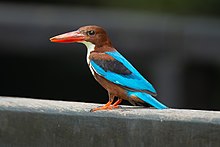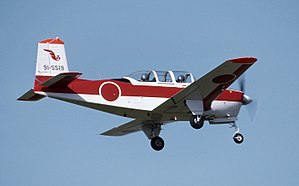흰줄무늬왕뱀붙이
White-throated kingfisher
흰발톱갈매기(Halcyon smyrnensis)라고도 하는 흰발톱갈매기(Halcyon smyrnensis)는 나무갈매기로, 시나이 동쪽에서부터 인도 아대륙을 거쳐 필리핀까지 아시아에 널리 분포하고 있다. 비록 몇몇 사람들이 단거리 이동을 할 수 있지만, 이 어부들은 그것의 범위의 많은 부분에 걸쳐 거주한다. 그것은 종종 작은 파충류, 양서류, 게, 작은 설치류, 심지어 새까지 포함하는 광범위한 먹이를 먹는 물에서 멀리 떨어져서 발견될 수 있다. 번식기에는 도시 지역의 건물 꼭대기나 전선을 포함한 두드러진 초원에서 아침에 큰 소리로 부른다.
분류학
흰줄무늬의 왕피셔는 1758년 스웨덴의 자연주의자 칼 리나에우스가 그의 시스템아 나투래 10번째 판에 처음으로 공식적으로 묘사한 많은 새들 중 하나이다. 그는 알케도 스미르넨시스라는 이항식 이름을 만들었다.[2][3] 리나에우스는 "Smirna Kingfisher"[4]의 설명과 판을 포함한 1738년에 출판된 Eleazar Albin의 <새의 자연사>를 인용했다. 현재의 Halcyon 속은 1821년 영국의 자연주의자이자 예술가 William John Swineson에 의해 소개되었다.[5] 할시온(Halcyon)은 그리스 신화에 나오는 새의 이름으로 일반적으로 왕피셔와 관련이 있다. smyrnensis라는 구체적인 수식어는 터키 이즈미르 마을의 형용사다.[6]
- H. s. smyrnensis (Linnaeus, 1758) – 터키 남부에서 이집트 북동쪽으로, 이라크에서 인도 북서쪽으로
- H. s. 푸스카(Boddaert, 1783) – 서인도 및 스리랑카
- H. s. perpulchra Madarasz, 1904 – 부탄에서 동인도, 인도차이나, 말레이 반도, 서 자바
- H. S. 새터티어 흄, 1874년 – 안다만 제도
- H. s. fokiensis Laubmann & Göz, 1926 – 중국 및 동부, 대만, 하이난
- H. s. gularis (Kuhl, 1820) – 필리핀
종족 H. s. gularis는 때때로 별개의 종으로 간주된다.[8] 이 치료법에 대한 지원은 2017년 발표된 분자 연구에서 H. s. gularis가 자바 왕피셔(H. ciaoventris)와 백로마 왕피셔(H. ciaoventris)와 더 밀접하게 관련되어 있다는 사실을 밝혀냈다.[9] H. s. perpulchra와 H. s. fokiensis는 때때로 H. s. fusca에 포함된다.[10]
Local names include Baluchistan: aspi chidok; Sindhi: dalel; Hindi: kilkila, kourilla; Himachal Pradesh: neela machhrala; Punjabi: wadda machhera; Bengali: sandabuk machhranga; Assamese: māsorokā, মাছৰোকা; Cachar: dao natu gophu; Gujarati: kalkaliyo, safedchati kalkaliyo; Marathi: khundya; Tamil: vichuli; Telugu: lakmuka, buchegadu; Malayalam: ponma; 칸나다: 민철리(ಮchulಂುಳಳಿಿ),라자마츠시; 신할라어:[11]필리후두와
설명


이것은 길이가 27–28 센티미터(10.6–11.0인치)인 대형 황제다. 그 성인은 밝은 파란색 등과 날개 그리고 꼬리를 가지고 있다. 머리, 어깨, 옆구리, 아랫배는 밤색이고, 목과 가슴은 흰색이다. 큰 지폐와 다리는 밝은 빨간색이다. 흰줄무늬가 있는 왕피셔의 비행은 빠르고 직접적이며, 짧고 둥근 날개가 윙윙거린다. 비행 중 파란색과 검은색 날개에 커다란 흰색 패치가 보인다. 성별은 비슷하지만, 청소년은 어른을 더 둔하게 보는 버전이다.[12]
이 종은 할시온 시아노벤트리스와 초종을 이루고 있으며, 대부분의 주요 작품들은 4개의 지리적 인종을 인정하고 있다. 그것들은 임상적으로 크기가 다양하며, 스미르넨시스와 푸스카에서는 더 푸르른 색조의 맨틀에 있는 파란색과 사타티오르에서는 더 파랗거나 보라색이다. 필리핀의 H. s. gularis는 목과 목만 하얗다. 그것은 때때로 뚜렷한 종인 H. gularis로 취급된다. 레이스 푸스카는 인도 반도, 스리랑카에서 발견되며 인도 북서부에서 발견된 지명 레이스에 비해 약간 작고 푸르르며 밑부분이 더 짙은 갈색이다. 레이스 새터티오는 안다만 제도에서 발견되며, 더 크고 짙은 갈색 밑부분이 있다. 인종 과펄크라(항상 인정되지 않는 것)는 인도 북동부에서 발견되며, 하부 파트가 더 많은 후스카보다 작다.[13] 알비니즘은 때때로 주목받았다.[14]
분포 및 서식지
흰목갈비갈매기는 다양한 서식지에서 흔히 볼 수 있는 종으로 주로 평야(히말라야[15] 7500피트)에 나무, 전선 또는 다른 보초가 있는 곳이 많다. 종의 범위가 넓어지고 있다.
이 어부들은 널리 퍼져있고 인구는 위협받지 않는다. km당2 평균 4.58명의 개인 밀도. 순다르반스 맹그로브에서 주목받았다.[16]
행동과 생태학
사육
흰줄기를 가진 왕새우는 몬순의 시작과 함께 번식을 시작한다. 수컷들은 자기 지역의 저명한 고위직에 앉아 이른 아침에 전화를 한다. 꼬리는 지금 깜박일 수 있고 구애 표시에서 날개는 흰색 날개 거울을 드러내면서 1~2초 동안 뻣뻣하게 휙 열렸다. 지폐를 높이 들어 흰 목구멍과 앞가슴을 드러내기도 한다. 초대에 응한 암컷은 빠르고 긴 키트 키트 콜을 한다. 둥지는 지구 둑에 있는 터널(길이 50cm, 3피트 터널이 있는[17] 둥지)이다. 보금자리 건물은 횃불을 찾을 수 있는 곳에 움푹 패인 곳이 만들어질 때까지 양쪽 새들이 적합한 흙벽으로 날아가는 것으로 시작한다. 그들은 그 후에 그들의 지폐로 둥지를 파고 계속해서 땅을 판다. 건초 더미의 둥지 터널도 기록돼 있다.[18] 동그란 흰 달걀 4-7개의 단일 클러치가 대표적이다. 알은 부화하는데 20~22일이 걸리고 병아리는 19일 만에 싹이 튼다.[19][20][21]
먹이와 다이어트
그것은 자국 영토 내에 있는 전선이나 다른 노출된 움푹 들어간 곳에 눈에 잘 띄며 남아시아에서는 자주 볼 수 있는 것이다. 이 종은 주로 큰 갑각류,[22] 곤충, 지렁이,[23] 설치류, 뱀, 물고기, 개구리를 사냥한다.[24][25] 인도 흰눈썹, 붉은갈색의 벼룩 병아리, 참새, 문어 등의 작은 새들의 포식 현상이 보고되고 있다.[19][26][27] 젊은이들은 대부분 무척추동물을 먹고 산다.[28] 포획된 상태에서는 규칙적으로 목욕을 하지만 물을 거의 마시지 않는다는 것이 주목되어 왔다.[29]
동작
특히 장마철에는 가끔 밤에 조명에 끌리는 새들이 보여서 부분적으로 철새라는 것을 알 수 있다.[19]
사망률
강력한 지폐와 빠른 비행으로, 이 왕비들은 건강하고 희귀한 검은 연과[30] 정글 까마귀가 병들거나 다친 새일 때 포식자가 거의 없다.[31] 나무의 숲에 부리를 박고 죽은 채 발견된 개인은 아마도 인도 흰눈일 가능성이 있는 먹이를 빠르게 쫓던 중 사고로 추정되고 있다.[27] 몇몇 기생충이 눈에 띄었다.[32]
1800년대에 이 새들은 모자를 장식하는데 사용되는 밝은 깃털 때문에 사냥되었다.[33] 그것은 웨스트 벵골 주의 새다.[34]
참조
- ^ BirdLife International (2016). "Halcyon smyrnensis". IUCN Red List of Threatened Species. 2016: e.T22725846A119289544. Retrieved 21 July 2020.
- ^ Linnaeus, Carl (1758). Systema Naturæ per regna tria naturae, secundum classes, ordines, genera, species, cum characteribus, differentiis, synonymis, locis, Volume 1 (in Latin) (10th ed.). Holmiae (Stockholm): Laurentii Salvii. p. 116.
- ^ Peters, James Lee, ed. (1945). Check-list of Birds of the World. Volume 5. Cambridge, Massachusetts: Harvard University Press. p. 196.
volume=추가 텍스트(도움말) - ^ Albin, Eleazar; Derham, William (1738). A natural history of birds : illustrated with a hundred and one copper plates, curiously engraven from the life. Volume 3. London: Printed for the author and sold by William Innys. p. 26, Plate 27.
volume=추가 텍스트(도움말) - ^ Swainson, William John (1821). Zoological illustrations. Volume 1. London: Baldwin, Cradock, and Joy; and W. Wood. Plate 27 text.
volume=추가 텍스트(도움말) - ^ Jobling, James A. (2010). The Helm Dictionary of Scientific Bird Names. London: Christopher Helm. pp. 185, 358. ISBN 978-1-4081-2501-4.
- ^ Gill, Frank; Donsker, David, eds. (2017). "Rollers, ground rollers & kingfishers". World Bird List Version 7.2. International Ornithologists' Union. Retrieved 28 May 2017.
- ^ del Hoyo, J.; Collar, N.; Kirwan, G.M. (2017). del Hoyo, J.; Elliott, A.; Sargatal, J.; Christie, D.A.; de Juana, E. (eds.). "White-throated Kingfisher (Halcyon gularis)". Handbook of the Birds of the World Alive. Lynx Edicions. Retrieved 25 May 2017.
- ^ Andersen, M.J.; McCullough, J.M.; Mauck III, W.M.; Smith, B.T.; Moyle, R.G. (2017). "A phylogeny of kingfishers reveals an Indomalayan origin and elevated rates of diversification on oceanic islands". Journal of Biogeography. 45 (2): 1–13. doi:10.1111/jbi.13139.
- ^ Woodall, P.F.; Kirwan, G.M. (2017). del Hoyo, J.; Elliott, A.; Sargatal, J.; Christie, D.A.; de Juana, E. (eds.). "White-breasted Kingfisher (Halcyon smyrnensis)". Handbook of the Birds of the World Alive. Lynx Edicions. Retrieved 25 May 2017.
- ^ Anonymous (1998). "Vernacular Names of the Birds of the Indian Subcontinent" (PDF). Buceros. 3 (1): 53–109. Archived from the original (PDF) on 2010-04-01. Retrieved 2008-10-19.
- ^ Fry, C. H.; Fry, K.; Harris, A. (1992). Kingfishers, Bee-eaters, and Rollers. London: Christopher Helm. pp. 143–145. ISBN 978-0-7136-8028-7.
- ^ Rasmussen, Pamela C.; Anderton, John C. (2012). Birds of South Asia. The Ripley Guide. Volume 2: Attributes and Status (2nd ed.). Washington D.C. and Barcelona: Smithsonian National Museum of Natural History and Lynx Edicions. pp. 264–265. ISBN 978-84-96553-87-3.
volume=추가 텍스트(도움말) - ^ Gunawardana, J. (1993). "Description of an albino White-breasted Kingfisher (Halcyon smyrnensis)". Ceylon Bird Club Notes (June): 56–57.
- ^ Khacher, Lavkumar J (1970). "Notes on the White-eye (Zosterops palpebrosa) and Whitebreasted Kingfisher (Halcyon smyrnensis)". Journal of the Bombay Natural History Society. 67 (2): 333.
- ^ Reza, A.H.M.A.; Feeroz, M.M.; Islam, M.A. & Kabir, M.M. (2003). "Status and density of kingfishers (family: Alcedinidae, Halcyonidae and Cerylidae) in the Sundarbans mangrove forest, Bangladesh" (PDF). Bangladesh Journal of Life Sciences. 15 (1): 55–60.
- ^ Law, SC (1925). "Nesting habits of the Indian Whitebreasted Kingfisher Halcyon smyrnensis fusca". Journal of the Bombay Natural History Society. 30 (2): 477–478.
- ^ Balasubramanian, P (1992). "New nesting site of the Indian Whitebreasted Kingfisher Halcyon smyrnensis fusca (Boddaert)". Journal of the Bombay Natural History Society. 89 (1): 124.
- ^ Jump up to: a b c Ali, S. & Ripley, S.D. (1983). Handbook of the birds of India and Pakistan. 4 (Second ed.). Oxford: Oxford University Press. pp. 90–93.
- ^ Palkar SB; Lovalekar RJ; Joshi VV (2009). "Breeding biology of White-breasted Kingfisher Halcyon smyrnensis" (PDF). Indian Birds. 4 (3): 104–105.
- ^ Hume, AO (1890). The nests and eggs of Indian birds. 3 (2nd ed.). R H Porter, London. pp. 15–19.
- ^ Tehsin, Raza (1995). "Crab-eating by Whitebreasted Kingfisher Halcyon smyrnensis (Linn.)". Journal of the Bombay Natural History Society. 92 (1): 121.
- ^ Yahya, HSA; Yasmin, Shahla (1991). "Earthworms in the dietary of the Whitebreasted Kingfisher Halcyon smyrnensis (Linn.)". Journal of the Bombay Natural History Society. 88 (3): 454.
- ^ Roberts, T J; Priddy, C (1965). "Food of the Whitebreasted Kingfisher Halcyon smyrnensis (Linnaeus)". Journal of the Bombay Natural History Society. 62 (1): 152–153.
- ^ Tehsin, Raza (1989). "Feeding behaviour of Whitebreasted Kingfisher Halcyon smyrnensis (Linnaeus)". Journal of the Bombay Natural History Society. 86 (3): 449.
- ^ Sen, SN (1944). "Food of the White-breasted Kingfisher (Halcyon smyrnensis fusca)". Journal of the Bombay Natural History Society. 44 (3): 475.
- ^ Jump up to: a b Purandare, Kiran Vasant (2008). "Freak accidental death of a White-breasted Kingfisher Halcyon smyrnensis" (PDF). Indian Birds. 4 (1): 23.
- ^ Burton NHK (1998). "Notes on the diet of nestling White-throated Kingfishers Halcyon smyrnensis in Malaysia" (PDF). Forktail. 14: 79–80. Archived from the original (PDF) on 2008-10-11. Retrieved 2008-10-02.
- ^ Harper, EW (1900–1901). "The White-breasted Kingfisher Halcyon smyrnensis in captivity". Journal of the Bombay Natural History Society. 13 (2): 364–365.
- ^ Narayanan, E (1989). "Pariah Kite Milvus migrans capturing Whitebreasted Kingfisher Halcyon smyrnensis". Journal of the Bombay Natural History Society. 86 (3): 445.
- ^ Balasubramanian, P. (1990). "Behaviour of southern spotted owlet Athene brama brama (Temminck) and jungle crow (Temminck) and jungle crow Corvus macrorhynchos at Point Calimere, Tamil Nadu". Journal of the Bombay Natural History Society. 87 (1): 145.
- ^ Nandi, A.P.; De, N.C.; Majumdar, G. (1985). "Records of two new nematodes (Acuariidae) parasitizing kingfishers (Coraciiformes) of West Bengal India". Helminthologia. 22 (3): 161–170.
- ^ Lockwood, E. (1878). Natural history, sport and travel. W.H. Allen and Co. pp. 185–186.
- ^ "Government of India webpage for National and State symbols". Archived from the original on 2013-11-12.
추가 읽기
- Cramp, Stanley, ed. (1985). "Halcyon smyrnensis White-breasted Kingfisher". Handbook of the birds of Europe the Middle East and North Africa. The Birds of the Western Palearctic. Volume IV: Terns to Woodpeckers. Oxford: Oxford University Press. pp. 701–705. ISBN 0-19-857507-6.
- Mohanty, Banalata (2006). "Extracellular Accumulations in the Avian Pituitary Gland: Histochemical Analysis in Two Species of Indian Wild Birds". Cells Tissues Organs. 183 (2): 99–106. doi:10.1159/000095514. PMID 17053326. S2CID 27807234.
- Oommen, M; Andrews, MI (1996). "Awakening, roosting and vocalization behaviour of the Whitebreasted Kingfisher Halcyon smyrnensis fusca (Boddaert)". Pavo. 34 (1&2): 43–46.
- Oommen, M; Andrews, MI (1993). "Breeding biology of the Whitebreasted Kingfisher, Halcyon smyrnensis". In Verghese, A; Sridhar, S; Chakravarthy, AK (eds.). Bird Conservation: Strategies for the Nineties and Beyond. Ornithological Society of India, Bangalore. pp. 177–180.
- 옴므엔, M; 앤드류스, MI(1998) 화이트브레어 킹피셔 할시온 스미르넨시스의 음식과 먹이 습관. 19장 인: 농업 생태계의 새들. (Eds: 딘사, MS; Rao, P Syamsunder; Parasharya, BM) 응용 조류학 협회, 하이데라바드, 132–136.
- Ticehurst, CB (1927). "Remarks on races of Halcyon smyrnensis and descriptions of two new subspecies – Zosterops palpebrosa occidentis and Z.P. nilgiriensis". Bull. Brit. Orn. Club. 47 (312): 87–90.
외부 링크
| 위키미디어 커먼즈에는 할시온 스미르넨시스와 관련된 미디어가 있다. |
| 위키피아는 할시온 스미르넨시스와 관련된 정보를 가지고 있다. |
- 인터넷 버드 컬렉션의 흰줄무늬 왕피셔 비디오, 사진 및 소리
- 싱가포르 조류









